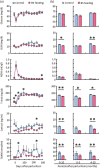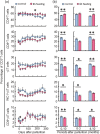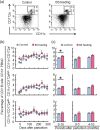Prevention of mastitis in multiparous dairy cows with a previous history of mastitis by oral feeding with probiotic Bacillus subtilis
- PMID: 36085592
- PMCID: PMC9541589
- DOI: 10.1111/asj.13764
Prevention of mastitis in multiparous dairy cows with a previous history of mastitis by oral feeding with probiotic Bacillus subtilis
Abstract
Mastitis is a very common inflammatory disease of the mammary gland of dairy cows, resulting in a reduction of milk production and quality. Probiotics may serve as an alternative to antibiotics to prevent mastitis, and the use of probiotics in this way may lessen the risk of antibiotic resistant bacteria developing. We investigated the effect of oral feeding of probiotic Bacillus subtilis (BS) C-3102 strain on the onset of mastitis in dairy cows with a previous history of mastitis. BS feeding significantly decreased the incidence of mastitis, the average number of medication days and the average number of days when milk was discarded, and maintained the mean SCC in milk at a level substantially lower than the control group. BS feeding was associated with lower levels of cortisol and TBARS and increased the proportion of CD4+ T cells and CD11c+ CD172ahigh dendritic cells in the blood by flow cytometry analysis. Parturition increased the migrating frequency of granulocytes toward a milk chemoattractant cyclophilin A in the control cows, however, this was reduced by BS feeding, possibly indicating a decreased sensitivity of peripheral granulocytes to cyclophilin A. These results reveal that B. subtilis C-3102 has potential as a probiotic and has preventative capacity against mastitis in dairy cows.
Keywords: Bacillus subtilis C-3102 strain; bovine mastitis; dairy cattle; probiotics; prophylactic effect.
© 2022 The Authors. Animal Science Journal published by John Wiley & Sons Australia, Ltd on behalf of Japanese Society of Animal Science.
Conflict of interest statement
The authors declare no conflict of interest.
Figures







Similar articles
-
Research progress on the association between mastitis and gastrointestinal microbes in dairy cows and the effect of probiotics.Microb Pathog. 2022 Dec;173(Pt A):105809. doi: 10.1016/j.micpath.2022.105809. Epub 2022 Sep 29. Microb Pathog. 2022. PMID: 36183956 Review.
-
Effects of Bacillus subtilis natto on milk production, rumen fermentation and ruminal microbiome of dairy cows.Animal. 2013 Feb;7(2):216-22. doi: 10.1017/S1751731112001188. Epub 2012 Jun 29. Animal. 2013. PMID: 23031615 Clinical Trial.
-
Evaluation of fully oxidised β-carotene as a feed ingredient to reduce bacterial infection and somatic cell counts in pasture-fed cows with subclinical mastitis.N Z Vet J. 2021 Sep;69(5):285-293. doi: 10.1080/00480169.2021.1924091. Epub 2021 Jun 9. N Z Vet J. 2021. PMID: 33944703
-
Antimicrobial resistance of mastitis pathogens.Vet Clin North Am Food Anim Pract. 2012 Jul;28(2):165-85. doi: 10.1016/j.cvfa.2012.03.005. Epub 2012 Apr 28. Vet Clin North Am Food Anim Pract. 2012. PMID: 22664201 Review.
-
A randomized controlled trial to compare the use of homeopathy and internal Teat Sealers for the prevention of mastitis in organically farmed dairy cows during the dry period and 100 days post-calving.Homeopathy. 2010 Apr;99(2):90-8. doi: 10.1016/j.homp.2009.12.001. Homeopathy. 2010. PMID: 20471611
Cited by
-
Akkermansia muciniphila-Derived Outer Membrane Vesicles as a Novel Therapeutic Approach for Mastitis: Insights From In Vitro and Vivo Studies.FASEB J. 2025 Jul 15;39(13):e70770. doi: 10.1096/fj.202500877RR. FASEB J. 2025. PMID: 40586785 Free PMC article.
-
Alternatives to antibiotics for treatment of mastitis in dairy cows.Front Vet Sci. 2023 Jun 19;10:1160350. doi: 10.3389/fvets.2023.1160350. eCollection 2023. Front Vet Sci. 2023. PMID: 37404775 Free PMC article. Review.
-
Genomic and In Vitro Analysis of Pediococcus pentosaceus MBBL4 Implicated Its Therapeutic Use Against Mastitis Pathogens and as a Potential Probiotic.Probiotics Antimicrob Proteins. 2025 Feb 20. doi: 10.1007/s12602-025-10484-8. Online ahead of print. Probiotics Antimicrob Proteins. 2025. PMID: 39976902
-
Effect of probiotic Lactobacillus plantarum CM49 on microbial profile and lactobacilli counts in milk of mastitic cattle.BMC Microbiol. 2025 Mar 1;25(1):109. doi: 10.1186/s12866-025-03832-9. BMC Microbiol. 2025. PMID: 40025414 Free PMC article.
-
Draft genome sequences of 21 Bacillus sp. isolates from raw bovine milk.Microbiol Resour Announc. 2024 Sep 10;13(9):e0056924. doi: 10.1128/mra.00569-24. Epub 2024 Aug 20. Microbiol Resour Announc. 2024. PMID: 39162440 Free PMC article.
References
-
- Bar, D. , Gröhn, Y. T. , Bennett, G. , González, R. N. , Hertl, J. A. , Schulte, H. F. , Tauer, L. W. , Welcome, F. L. , & Schukken, Y. H. (2008). Effects of repeated episodes of generic clinical mastitis on mortality and culling in dairy cows. Journal of Dairy Science, 91(6), 2196–2204. 10.3168/jds.2007-0460 - DOI - PubMed
MeSH terms
Substances
Grants and funding
LinkOut - more resources
Full Text Sources
Research Materials

